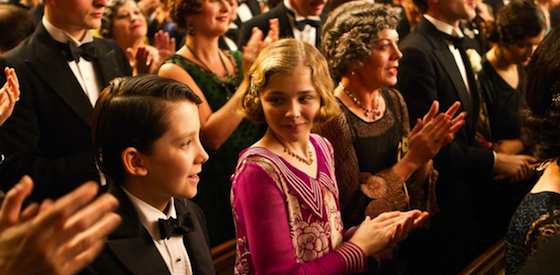- MENU
- HOME
- SEARCH
- WORLD
- MAIN
- AFRICA
- ASIA
- BALKANS
- EUROPE
- LATIN AMERICA
- MIDDLE EAST
- United Kingdom
- United States
- Argentina
- Australia
- Austria
- Benelux
- Brazil
- Canada
- China
- France
- Germany
- Greece
- Hungary
- India
- Indonesia
- Ireland
- Israel
- Italy
- Japan
- Korea
- Mexico
- New Zealand
- Pakistan
- Philippines
- Poland
- Russia
- South Africa
- Spain
- Taiwan
- Turkey
- USA
- BUSINESS
- WEALTH
- STOCKS
- TECH
- HEALTH
- LIFESTYLE
- ENTERTAINMENT
- SPORTS
- RSS
- iHaveNet.com: Movie Reviews

3 Stars
Rich and stimulating even when it wanders, director Martin Scorsese's first 3-D effort, "Hugo," takes place mostly within the confines of a railway station modeled on Montparnasse. The story, developed by screenwriter John Logan from Brian Selznick's graphic novel "The Invention of Hugo Cabret," ranges beyond the station. But every locale in Scorsese's vision of 1931 Paris looks and feels like another planet. The filmmaker embraces storybook artifice as wholeheartedly as he relays the tale's lessons in the importance of film preservation.
Wait. "Hugo" is about film preservation? I though it was about an orphan who lives in the walls of the station and maintains the clockworks and acquires a mysterious automaton and ... well, it's both. It's a few different things.
"Time hasn't been kind to old movies," bemoans the cinema historian played by Michael Stuhlbarg who comes to the rescue of early silent film pioneer Georges Melies in "Hugo." Scorsese has long dedicated his time and efforts to saving endangered celluloid. Would that more directors today had his resolve: An estimated 80 to 90 percent of the silent film era's output is already lost. "Hugo," which is two sorts of kids' movies (both about and for older kids) as well as a lavish tribute to Melies, played by Ben Kingsley, culminates Scorsese's efforts in that direction.
The world of "Hugo" relates strongly to much of Scorsese's other recent, aggressively stylized work with scenic designer Dante Ferretti. The suffocating madhouse of "Shutter Island"; the street scenes of "Gangs of New York"; the delirious aerial sequences of "The Aviator" (also written by Logan): None of this has anything to do with any sort of realism. In each of these projects, Scorsese delved into his steroidal memories of the medium. As much as I love much of Scorsese, his recent, grandiose efforts don't strike me as anywhere near his best. "Hugo" is big, and it exists mainly to dazzle, but its storytelling ambitions are more modest. I enjoyed it more than many a later Scorsese picture.
Asa Butterfield plays young Hugo, whose late, loving father (Jude Law) left him with a knack for clockwork and a longing for family. Ever since the disappearance of his drunken sot of a guardian (Ray Winstone), this boy has lived solo, keeping away from the suspicious eye of the station inspector (Sacha Baron Cohen). Inspired by the real-life Melies, who ran a toy concession at the Montparnasse station, "Hugo" imagines "Papa Georges" (Kingsley) and his goddaughter (Chloe Grace Moretz, one of the few Americans in a mostly British cast) as the most enticing curiosities in the building. How Melies' story intersects with Hugo's provides Scorsese with his narrative tissue.
That tissue, it must be said, is thin. Despite Logan's best efforts, the vignettes involving a tentative romance between the station inspector and a flower seller played by Emily Mortimer lack dimensional reasons for being, as do minor characters played by Christopher Lee and others. The more prominent Melies becomes in the telling of "Hugo," however, the more rewarding the results. Near the end, "Hugo" shoves Hugo himself off to the side of his own story, focusing instead (as did the book) on the resurrection of silent film legend Melies. Scorsese clearly relished recreating scenes depicting the making of Melies' 14-minute 1902 landmark fantasy "A Trip to the Moon."
Much of this is the result of swanky art direction and Robert Richardson's pearly cinematography, but it's also due to Scorsese's sense of wonder. His sense of humor is less sure. An early slapstick sequence, in which Cohen's artificial leg gets snagged by a locomotive, doesn't set up the ground rules for danger clearly enough (Is this man going to die? Is it supposed to be funny?) Scorsese is dealing with source material (Selznick's, that is) that might've been best confined to about 107 minutes of movie, i.e., 20 minutes fewer than we have.
Still: A lot of "Hugo" is pictorially entrancing and quite moving. And there's one shot of the inspector in his tub, muttering aloud about Hugo's whereabouts, followed by Scorsese's cutaway to the man's enormous Doberman sitting in the same tub. It's the silliest moment in a movie not much interested in jokes. It may also be the niftiest use of a dog on the big screen since Frank Tashlin deployed a dachshund in CinemaScope in "Bachelor Flat" nearly 50 years ago.
Hugo Movie Review - Ben Kingsley and Asa Butterfield